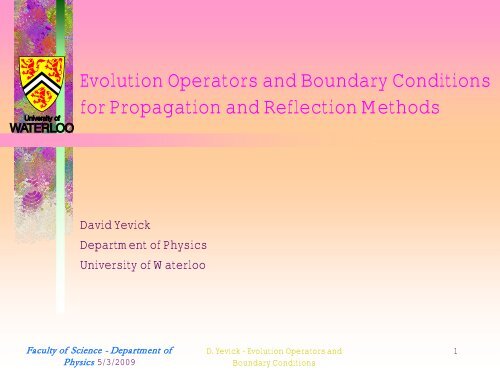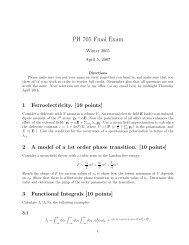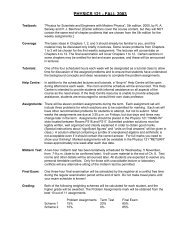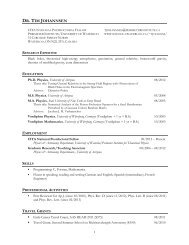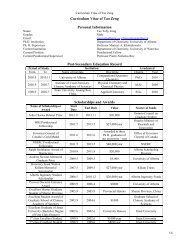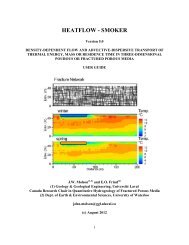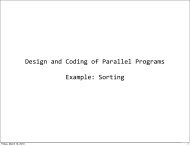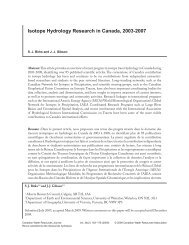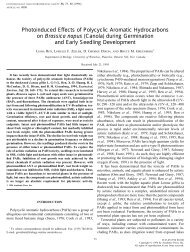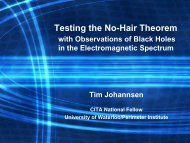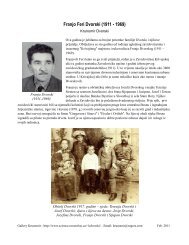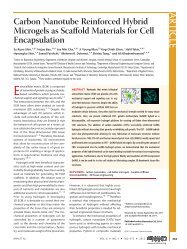here - Faculty of Science - University of Waterloo
here - Faculty of Science - University of Waterloo
here - Faculty of Science - University of Waterloo
Create successful ePaper yourself
Turn your PDF publications into a flip-book with our unique Google optimized e-Paper software.
Evolution Operators and Boundary Conditions<br />
for Propagation and Reflection Methods<br />
David Yevick<br />
Department <strong>of</strong> Physics<br />
<strong>University</strong> <strong>of</strong> <strong>Waterloo</strong><br />
<strong>Faculty</strong> <strong>of</strong> <strong>Science</strong> - Department <strong>of</strong><br />
Physics 5/3/2009<br />
D. Yevick - Evolution Operators and<br />
Boundary Conditions<br />
1
Collaborators<br />
• Frank Schmidt (ZIB)<br />
• Tilmann Friese (ZIB, <strong>University</strong> <strong>of</strong> <strong>Waterloo</strong>]<br />
• Hatem El-Refaei, Nortel Networks<br />
• Ian Betty, Nortel Networks<br />
• Chunlin Yu, Queen’s <strong>University</strong><br />
<strong>Faculty</strong> <strong>of</strong> <strong>Science</strong> - Department <strong>of</strong><br />
Physics 5/3/2009<br />
D. Yevick - Evolution Operators and<br />
Boundary Conditions<br />
2
Outline<br />
• Fundamental Equations<br />
• Non-Local Boundary Conditions<br />
• Improving Accuracy in Fast Reflection<br />
Calculations<br />
<strong>Faculty</strong> <strong>of</strong> <strong>Science</strong> - Department <strong>of</strong><br />
Physics 5/3/2009<br />
D. Yevick - Evolution Operators and<br />
Boundary Conditions<br />
3
Part I - Fundamental Equations<br />
<strong>Faculty</strong> <strong>of</strong> <strong>Science</strong> - Department <strong>of</strong><br />
Physics 5/3/2009<br />
D. Yevick - Evolution Operators and<br />
Boundary Conditions<br />
4
Scalar Wave Equation<br />
• Scalar, Monochromatic Electric Field<br />
⎛ ∂<br />
⎜<br />
⎝ ∂z<br />
Defining<br />
Y<br />
0<br />
2<br />
⎛ ∂<br />
⎜<br />
⎝ ∂z<br />
2<br />
2<br />
=<br />
2<br />
+<br />
k<br />
+<br />
0<br />
∂<br />
2<br />
∂x<br />
k<br />
2<br />
n<br />
1 ∂<br />
2 2<br />
n ∂y<br />
2<br />
0<br />
0<br />
0<br />
n<br />
∂<br />
+<br />
∂y<br />
= n<br />
2<br />
0<br />
2<br />
2<br />
( X<br />
2<br />
0<br />
2<br />
+<br />
k<br />
reference<br />
, X<br />
and N =<br />
+ Y<br />
0<br />
2<br />
0<br />
n<br />
2<br />
⎞<br />
( r )<br />
⎟ Ε( x,<br />
y,<br />
z)<br />
= 0<br />
⎠<br />
0<br />
2<br />
1 ∂<br />
= ,<br />
2 2 2<br />
k0<br />
n ∂x<br />
0<br />
2 <br />
n ( r )<br />
−1,<br />
we have<br />
2<br />
n<br />
0<br />
⎞<br />
+ N)<br />
⎟ E( x,<br />
y,<br />
z)<br />
= 0<br />
⎠<br />
<strong>Faculty</strong> <strong>of</strong> <strong>Science</strong> - Department <strong>of</strong><br />
Physics 5/3/2009<br />
D. Yevick - Evolution Operators and<br />
Boundary Conditions<br />
5
Forward Solution<br />
• Define H = X<br />
0<br />
+ Y0<br />
+ N . For forwardtravelling<br />
waves ( time-dependence<br />
i t<br />
)<br />
E( x,<br />
y,<br />
z<br />
+ ∆z)<br />
=<br />
e<br />
δ∆z 1+H<br />
E( x<br />
y<br />
z<br />
⎛<br />
⎜<br />
⎝<br />
∂<br />
∂z<br />
+<br />
e ω , , )<br />
⎞<br />
ik0 n0<br />
1+<br />
H ⎟ E( x,<br />
y,<br />
z)<br />
=<br />
⎠<br />
0<br />
• We then have with<br />
δ = −ik 0 n 0<br />
<strong>Faculty</strong> <strong>of</strong> <strong>Science</strong> - Department <strong>of</strong><br />
Physics 5/3/2009<br />
D. Yevick - Evolution Operators and<br />
Boundary Conditions<br />
6
Modal Analysis<br />
• Modal Decomposition<br />
E( x,<br />
y,<br />
z)<br />
= ∑ a<br />
m<br />
m<br />
E<br />
m<br />
( x,<br />
y,<br />
z)<br />
with<br />
⎡ ∂<br />
⎢<br />
⎣∂x<br />
2<br />
2<br />
+<br />
∂<br />
2<br />
∂y<br />
2<br />
+<br />
k<br />
2<br />
0<br />
n<br />
2<br />
( x,<br />
⎤<br />
y,<br />
z)<br />
⎥ E<br />
⎦<br />
m<br />
( x,<br />
y,<br />
z)<br />
=<br />
β ( x,<br />
2<br />
m<br />
y,<br />
z) E<br />
m<br />
( x,<br />
y,<br />
z)<br />
• Approximate Forward Solution<br />
E(<br />
∑<br />
−iβ<br />
m ( x,<br />
y,<br />
z ) ∆z<br />
x,<br />
y,<br />
z + ∆z)<br />
= e E<br />
m<br />
( x,<br />
y,<br />
z)<br />
m<br />
<strong>Faculty</strong> <strong>of</strong> <strong>Science</strong> - Department <strong>of</strong><br />
Physics 5/3/2009<br />
D. Yevick - Evolution Operators and<br />
Boundary Conditions<br />
7
Fresnel Approximation<br />
• Fresnel Approximation<br />
1<br />
+<br />
H ≈ 1+<br />
H<br />
2<br />
• Slowly-Varying Envelope<br />
E(<br />
x,<br />
y,<br />
z)<br />
= E( x,<br />
y,<br />
z)<br />
e<br />
−δ z<br />
⎛<br />
⎜<br />
⎝<br />
∂<br />
∂z<br />
δ<br />
⎞<br />
+ ( X<br />
0<br />
+ Y0<br />
+ N)<br />
⎟E(<br />
x,<br />
y,<br />
z)<br />
=<br />
2<br />
⎠<br />
0<br />
<strong>Faculty</strong> <strong>of</strong> <strong>Science</strong> - Department <strong>of</strong><br />
Physics 5/3/2009<br />
D. Yevick - Evolution Operators and<br />
Boundary Conditions<br />
8
Wide-Angle Approximations<br />
• Taylor Series Expansion<br />
1 1 2 1 3 5 4<br />
1+<br />
H ≈ 1+<br />
H − H + H − H + O(<br />
H<br />
2 8 16 128<br />
• Padé [2,0] approximant:<br />
1+<br />
H<br />
≈ 1+<br />
H<br />
2<br />
H<br />
−<br />
8<br />
• Padé [1,1] approximant<br />
1+<br />
H<br />
1+<br />
3H<br />
/ 4<br />
≈<br />
1+<br />
H / 4<br />
1<br />
= 1+<br />
H −<br />
2<br />
2<br />
1<br />
8<br />
H<br />
2<br />
+<br />
1<br />
32<br />
H<br />
3<br />
−<br />
1<br />
128<br />
H<br />
4<br />
5<br />
)<br />
+ O(<br />
H<br />
5<br />
)<br />
<strong>Faculty</strong> <strong>of</strong> <strong>Science</strong> - Department <strong>of</strong><br />
Physics 5/3/2009<br />
D. Yevick - Evolution Operators and<br />
Boundary Conditions<br />
9
Square-Root Operator Recursion<br />
• Recursion Relation<br />
1+<br />
H −1<br />
=<br />
=<br />
=<br />
( 1+<br />
H −1)<br />
1+<br />
2 +<br />
H<br />
H + 1<br />
H<br />
⎛<br />
⎜<br />
⎝<br />
1+<br />
1+<br />
( 1+<br />
H −1)<br />
H<br />
H<br />
+ 1⎞<br />
⎟<br />
+ 1<br />
⎠<br />
f<br />
• Thus if<br />
1 1 ) ( − + = H x<br />
we have<br />
f ( x)<br />
= x /(2 + f ( x))<br />
<strong>Faculty</strong> <strong>of</strong> <strong>Science</strong> - Department <strong>of</strong><br />
Physics 5/3/2009<br />
D. Yevick - Evolution Operators and<br />
Boundary Conditions<br />
10
Continued Fraction Expansion<br />
• Iterating the recursion relation yields<br />
1+<br />
H<br />
−1<br />
=<br />
2<br />
• Note that we have employed f ( x)<br />
= 0<br />
to terminate the fraction, yielding a real<br />
expression.<br />
+<br />
2<br />
+<br />
H<br />
H<br />
...<br />
2<br />
H<br />
H<br />
+<br />
2<br />
<strong>Faculty</strong> <strong>of</strong> <strong>Science</strong> - Department <strong>of</strong><br />
Physics 5/3/2009<br />
D. Yevick - Evolution Operators and<br />
Boundary Conditions<br />
11
Padé Representations<br />
• The Padé approximant can be factored as<br />
1+<br />
H<br />
≈<br />
s<br />
∏<br />
⎡<br />
⎢1+<br />
sin<br />
⎢<br />
⎢<br />
⎢<br />
1+<br />
cos<br />
⎣<br />
r=<br />
1 2<br />
⎛ rπ<br />
⎞<br />
⎜ ⎟H<br />
⎝ 2s<br />
+ 1⎠<br />
⎛ rπ<br />
⎞<br />
⎜ ⎟H<br />
⎝ 2s<br />
+ 1⎠<br />
• In a partial fraction representation<br />
2<br />
⎤<br />
⎥<br />
⎥<br />
⎥<br />
⎥<br />
⎦<br />
1+<br />
H<br />
<strong>Faculty</strong> <strong>of</strong> <strong>Science</strong> - Department <strong>of</strong><br />
Physics 5/3/2009<br />
= 1+<br />
s<br />
∑<br />
⎡ 2<br />
⎢<br />
⎢<br />
2s<br />
+<br />
⎢<br />
⎢<br />
1+<br />
cos<br />
⎣<br />
sin<br />
1<br />
r=<br />
1 2<br />
⎛<br />
⎜<br />
⎝<br />
⎛ rπ<br />
⎞<br />
⎜ ⎟H<br />
⎝ 2s<br />
+ 1⎠<br />
rπ<br />
⎞<br />
⎟H<br />
2s<br />
+ 1⎠<br />
D. Yevick - Evolution Operators and<br />
Boundary Conditions<br />
2<br />
⎤<br />
⎥<br />
⎥<br />
⎥<br />
⎥<br />
⎦<br />
12
Finite Difference Method<br />
• Applying a [1,1] Padé approximant yields the<br />
Crank-Nicholson procedure<br />
E(<br />
z<br />
+ ∆z)<br />
=<br />
e<br />
H<br />
δ<br />
2<br />
E(<br />
z)<br />
=<br />
e<br />
δ<br />
( X<br />
2<br />
0<br />
+ Y<br />
0<br />
+ N )<br />
E(<br />
z)<br />
≈<br />
⎛<br />
⎜<br />
⎝<br />
1<br />
1<br />
+<br />
−<br />
δ<br />
δ<br />
H<br />
H<br />
/<br />
/<br />
4<br />
4<br />
⎞<br />
⎟E(<br />
z)<br />
⎠<br />
+<br />
O(<br />
δ<br />
3<br />
)<br />
<strong>Faculty</strong> <strong>of</strong> <strong>Science</strong> - Department <strong>of</strong><br />
Physics 5/3/2009<br />
D. Yevick - Evolution Operators and<br />
Boundary Conditions<br />
13
Discrete Representation<br />
• On a one-dimensional transverse grid<br />
{ } x i<br />
E(<br />
x<br />
w<strong>here</strong><br />
D<br />
2<br />
x<br />
i<br />
E<br />
1−<br />
, z + ∆z)<br />
=<br />
1+<br />
i<br />
=<br />
E<br />
i+<br />
1<br />
− 2E<br />
∆z<br />
i<br />
2<br />
i∆z<br />
4k0n<br />
i∆z<br />
4k<br />
n<br />
+<br />
and for any operator O,<br />
0<br />
E<br />
0<br />
0<br />
i−1<br />
1<br />
O<br />
( k<br />
( k<br />
2<br />
0<br />
2<br />
0<br />
( n<br />
( n<br />
2<br />
2<br />
( x<br />
( x<br />
) − n<br />
) − n<br />
represents O<br />
i<br />
i<br />
2<br />
0<br />
2<br />
0<br />
−1<br />
) +<br />
) +<br />
.<br />
D<br />
D<br />
2<br />
x<br />
2<br />
x<br />
)<br />
)<br />
E(<br />
x<br />
i<br />
, z)<br />
<strong>Faculty</strong> <strong>of</strong> <strong>Science</strong> - Department <strong>of</strong><br />
Physics 5/3/2009<br />
D. Yevick - Evolution Operators and<br />
Boundary Conditions<br />
14
Part II - Nonlocal Boundary<br />
Conditions<br />
<strong>Faculty</strong> <strong>of</strong> <strong>Science</strong> - Department <strong>of</strong><br />
Physics 5/3/2009<br />
D. Yevick - Evolution Operators and<br />
Boundary Conditions<br />
15
Objective<br />
• To simulate on a finite, discrete<br />
computational grid the field radiated from<br />
a local source into a homogeneous semiinfinite<br />
medium.<br />
<strong>Faculty</strong> <strong>of</strong> <strong>Science</strong> - Department <strong>of</strong><br />
Physics 5/3/2009<br />
D. Yevick - Evolution Operators and<br />
Boundary Conditions<br />
16
Electrorefraction Modulator<br />
<strong>Faculty</strong> <strong>of</strong> <strong>Science</strong> - Department <strong>of</strong><br />
Physics 5/3/2009<br />
D. Yevick - Evolution Operators and<br />
Boundary Conditions<br />
17
Standard Boundary Conditions<br />
<strong>Faculty</strong> <strong>of</strong> <strong>Science</strong> - Department <strong>of</strong><br />
Physics 5/3/2009<br />
D. Yevick - Evolution Operators and<br />
Boundary Conditions<br />
18
Improved Boundary Conditions<br />
<strong>Faculty</strong> <strong>of</strong> <strong>Science</strong> - Department <strong>of</strong><br />
Physics 5/3/2009<br />
D. Yevick - Evolution Operators and<br />
Boundary Conditions<br />
19
Boundary Layers<br />
– The approximate propagation operators<br />
introduced above are unitary. To remove the<br />
outward propagating electric field at the<br />
boundary we can introduce absorbing or<br />
impedance-matched boundary layers.<br />
z<br />
x 1<br />
x<br />
N<br />
<strong>Faculty</strong> <strong>of</strong> <strong>Science</strong> - Department <strong>of</strong><br />
Physics 5/3/2009<br />
D. Yevick - Evolution Operators and<br />
Boundary Conditions<br />
20
Transparent Boundaries<br />
E E N + 1<br />
• Set 0 and to be consistent with<br />
purely outgoing waves at the boundary.<br />
– Local Boundary Conditions: E , 0<br />
E N +1 are<br />
computed from Eat the last propagation step.<br />
– Nonlocal Boundary Conditions: E0<br />
, E N +1 are<br />
obtained from previous values <strong>of</strong> .<br />
E<br />
<strong>Faculty</strong> <strong>of</strong> <strong>Science</strong> - Department <strong>of</strong><br />
Physics 5/3/2009<br />
D. Yevick - Evolution Operators and<br />
Boundary Conditions<br />
21
Impedance-Matched Layer<br />
• For a non-equidistant grid, ∆ X<br />
i<br />
= (1 − bi<br />
) ∆X<br />
the governing equation in a homogeneous<br />
refractive index layer near the boundary is<br />
⎛<br />
⎜−<br />
2ik<br />
⎝<br />
• For continuous<br />
• Thus, if<br />
E<br />
k<br />
∂<br />
d<br />
⎞<br />
)<br />
⎟E(<br />
x,<br />
y,<br />
z)<br />
⎠<br />
2<br />
2 2 2<br />
0<br />
n0<br />
+ + k0<br />
( n − n<br />
2<br />
b 0<br />
=<br />
∂z<br />
dx<br />
x, z<br />
b → ia<br />
i i<br />
x<br />
, k<br />
( x,<br />
z)<br />
z<br />
, no spurious effects.<br />
, we have<br />
∝<br />
e<br />
ik<br />
x<br />
(1+<br />
ia<br />
i<br />
) x+<br />
ik<br />
z<br />
z<br />
0<br />
<strong>Faculty</strong> <strong>of</strong> <strong>Science</strong> - Department <strong>of</strong><br />
Physics 5/3/2009<br />
D. Yevick - Evolution Operators and<br />
Boundary Conditions<br />
22
Impedance-Matched Layer<br />
Attenuation<br />
=<br />
e<br />
∑<br />
−2k<br />
∆x<br />
a −2k0n<br />
x<br />
l<br />
l<br />
=<br />
e<br />
b<br />
∆xsinθ<br />
∑<br />
l<br />
a<br />
l<br />
n b<br />
n(r <br />
Z = L a<br />
)<br />
n b<br />
θ<br />
/ tanθ<br />
x<br />
L a<br />
z<br />
<strong>Faculty</strong> <strong>of</strong> <strong>Science</strong> - Department <strong>of</strong><br />
Physics 5/3/2009<br />
D. Yevick - Evolution Operators and<br />
Boundary Conditions<br />
23
Approximate and Exact Results<br />
<strong>Faculty</strong> <strong>of</strong> <strong>Science</strong> - Department <strong>of</strong><br />
Physics 5/3/2009<br />
D. Yevick - Evolution Operators and<br />
Boundary Conditions<br />
24
Continuous Nonlocal Boundary<br />
<strong>Faculty</strong> <strong>of</strong> <strong>Science</strong> - Department <strong>of</strong><br />
Physics 5/3/2009<br />
D. Yevick - Evolution Operators and<br />
Boundary Conditions<br />
25
Continuous Nonlocal Boundary<br />
<strong>Faculty</strong> <strong>of</strong> <strong>Science</strong> - Department <strong>of</strong><br />
Physics 5/3/2009<br />
D. Yevick - Evolution Operators and<br />
Boundary Conditions<br />
26
Gaussian Beam - Continuous N.L.<br />
<strong>Faculty</strong> <strong>of</strong> <strong>Science</strong> - Department <strong>of</strong><br />
Physics 5/3/2009<br />
D. Yevick - Evolution Operators and<br />
Boundary Conditions<br />
27
Remaining Power - Continuous<br />
<strong>Faculty</strong> <strong>of</strong> <strong>Science</strong> - Department <strong>of</strong><br />
Physics 5/3/2009<br />
D. Yevick - Evolution Operators and<br />
Boundary Conditions<br />
28
Exact Nonlocal Boundary<br />
<strong>Faculty</strong> <strong>of</strong> <strong>Science</strong> - Department <strong>of</strong><br />
Physics 5/3/2009<br />
D. Yevick - Evolution Operators and<br />
Boundary Conditions<br />
29
Remaining Power - Discrete<br />
<strong>Faculty</strong> <strong>of</strong> <strong>Science</strong> - Department <strong>of</strong><br />
Physics 5/3/2009<br />
D. Yevick - Evolution Operators and<br />
Boundary Conditions<br />
30
Padé [1,1] Boundary Conditions<br />
• [1,1] Padé Approximation<br />
−1+<br />
1+<br />
H ≈<br />
• Claerbout’s Equation<br />
H / 2<br />
1+<br />
H / 4<br />
⎡⎛ 1 H ⎞ ∂ H ⎤<br />
⎢⎜<br />
+ ⎟ + δ ( , , )<br />
4 2<br />
⎥ E x y z<br />
⎣⎝<br />
⎠ ∂z<br />
⎦<br />
=<br />
• Boundary Condition Equation ( n b<br />
= n 0 )<br />
⎛<br />
⎜1<br />
+<br />
⎝<br />
X<br />
4<br />
0<br />
⎞⎡1−<br />
s ⎤<br />
⎟⎢<br />
E(<br />
z<br />
z ⎥<br />
⎠⎣<br />
∆ ⎦<br />
+ ∆z)<br />
X<br />
= − δ<br />
4<br />
0<br />
(1 +<br />
0<br />
s)<br />
E(<br />
z<br />
+ ∆z)<br />
<strong>Faculty</strong> <strong>of</strong> <strong>Science</strong> - Department <strong>of</strong><br />
Physics 5/3/2009<br />
D. Yevick - Evolution Operators and<br />
Boundary Conditions<br />
31
Padé [2,0] Boundary Conditions<br />
• [2,2] Padé Equation<br />
⎛1−<br />
s ⎞<br />
⎜ ⎟E<br />
⎝ ∆z<br />
⎠<br />
2<br />
⎛ X<br />
0<br />
X ⎞<br />
0 ⎛ 1+<br />
s ⎞<br />
+ 1(<br />
x)<br />
= −δ<br />
⎜1<br />
⎟<br />
+ − ⎜ ⎟E<br />
j 1(<br />
x)<br />
2 8<br />
⎝<br />
⎠⎝<br />
2 ⎠<br />
j +<br />
• Laplace transform this equation with<br />
respect to x in the exterior region.<br />
• Requiring that no poles are present in the<br />
right-hand plane <strong>of</strong> the transform yields the<br />
desired boundary condition.<br />
<strong>Faculty</strong> <strong>of</strong> <strong>Science</strong> - Department <strong>of</strong><br />
Physics 5/3/2009<br />
D. Yevick - Evolution Operators and<br />
Boundary Conditions<br />
32
[2,2] Boundary Condition Results<br />
<strong>Faculty</strong> <strong>of</strong> <strong>Science</strong> - Department <strong>of</strong><br />
Physics 5/3/2009<br />
D. Yevick - Evolution Operators and<br />
Boundary Conditions<br />
33
Padé [N,N] Boundary Conditions<br />
• For the [N,N] case,<br />
g<br />
g<br />
g<br />
(1)<br />
i<br />
(2)<br />
i<br />
( k −1)<br />
i<br />
sE<br />
⎛ ′ 2<br />
1 a ⎞<br />
1<br />
( x)<br />
⎜ − ∂<br />
x<br />
= ⎟E<br />
⎜<br />
2<br />
1−<br />
a1∂<br />
⎟<br />
x<br />
⎝ ⎠<br />
⎛ ′ 2<br />
1 a ⎞<br />
2 x<br />
( x)<br />
⎜ − ∂<br />
= ⎟g<br />
⎜<br />
2<br />
1−<br />
a ⎟<br />
2∂<br />
x<br />
⎝ ⎠<br />
<br />
i−1<br />
(1)<br />
i<br />
⎛ ′ 2<br />
1 a ⎞<br />
1<br />
( x)<br />
⎜ −<br />
k −<br />
∂<br />
x<br />
= ⎟g<br />
⎜<br />
2<br />
1−<br />
ak<br />
−1∂<br />
⎟<br />
x<br />
⎝ ⎠<br />
⎛ ′ 2<br />
1 a ⎞<br />
k x ( k<br />
Ei<br />
( x)<br />
⎜ − ∂<br />
= ⎟g<br />
2 i<br />
⎜ 1−<br />
a ⎟<br />
k∂<br />
x<br />
⎝ ⎠<br />
i<br />
( x)<br />
= E<br />
1(<br />
x)<br />
, w<strong>here</strong><br />
( x)<br />
( x)<br />
( k −2)<br />
i<br />
−1)<br />
( x)<br />
( x)<br />
i−<br />
<strong>Faculty</strong> <strong>of</strong> <strong>Science</strong> - Department <strong>of</strong><br />
Physics 5/3/2009<br />
D. Yevick - Evolution Operators and<br />
Boundary Conditions<br />
34
General Boundary Conditions (2)<br />
• Introducing a vector<br />
g<br />
g i<br />
(x) with<br />
( j)<br />
, j<br />
( x)<br />
= g<br />
i<br />
( x),<br />
j = 1k<br />
−1,<br />
g<br />
i,<br />
k<br />
( x)<br />
Ei<br />
( x)<br />
i<br />
=<br />
yields<br />
( E<br />
2<br />
+ A ∂ ) ( x)<br />
x g i<br />
with boundary conditions<br />
g<br />
B<br />
g<br />
g<br />
= 0<br />
B<br />
i, +<br />
=<br />
+ i,<br />
+<br />
,<br />
i,<br />
−<br />
=<br />
+ i,<br />
−<br />
g<br />
<strong>Faculty</strong> <strong>of</strong> <strong>Science</strong> - Department <strong>of</strong><br />
Physics 5/3/2009<br />
D. Yevick - Evolution Operators and<br />
Boundary Conditions<br />
35
General Boundary Conditions (3)<br />
• After Laplace transforming, this yields<br />
(<br />
2<br />
E + p A) g ( p)<br />
= A(<br />
pg<br />
+ g<br />
)<br />
or, defining C<br />
2 = −A<br />
−1 E ,<br />
• Problem: Construct<br />
<strong>of</strong> ( I + C) −1<br />
have<br />
ˆ<br />
i<br />
i,0<br />
i,<br />
0<br />
(<br />
2 2<br />
p I − C ) gˆ<br />
( p)<br />
= pg<br />
,0<br />
+ g<br />
, 0<br />
i<br />
i<br />
C<br />
p Rp<br />
> 0 j<br />
i<br />
such that all poles<br />
<strong>Faculty</strong> <strong>of</strong> <strong>Science</strong> - Department <strong>of</strong><br />
Physics 5/3/2009<br />
D. Yevick - Evolution Operators and<br />
Boundary Conditions<br />
36
[N,N] Boundary Condition Results<br />
<strong>Faculty</strong> <strong>of</strong> <strong>Science</strong> - Department <strong>of</strong><br />
Physics 5/3/2009<br />
D. Yevick - Evolution Operators and<br />
Boundary Conditions<br />
37
Part III - Improving Accuracy in<br />
Fast Reflection Calculations<br />
<strong>Faculty</strong> <strong>of</strong> <strong>Science</strong> - Department <strong>of</strong><br />
Physics 5/3/2009<br />
D. Yevick - Evolution Operators and<br />
Boundary Conditions<br />
38
Facet Reflection Coefficient<br />
E y<br />
∂<br />
E y<br />
• Matching and at the boundary gives<br />
∂z<br />
Ψ<br />
y<br />
= Ψ<br />
+<br />
o<br />
e<br />
−ik<br />
o<br />
n<br />
ol<br />
L<br />
l<br />
z<br />
+ Ψ<br />
−<br />
o<br />
e<br />
ik<br />
o<br />
n<br />
ol<br />
L<br />
l<br />
z<br />
A<br />
B<br />
( 1)<br />
E k +<br />
yr<br />
[ R]<br />
TE<br />
=<br />
=<br />
1 ( k<br />
L )(<br />
)<br />
B<br />
LA<br />
E<br />
yr<br />
(1 −<br />
2<br />
E<br />
E<br />
yr<br />
yi<br />
=<br />
n<br />
n<br />
oA<br />
oA<br />
L<br />
L<br />
A<br />
A<br />
−<br />
−<br />
+<br />
E<br />
n<br />
n<br />
yi<br />
oB<br />
oB<br />
)<br />
L<br />
L<br />
, or<br />
B<br />
B<br />
<strong>Faculty</strong> <strong>of</strong> <strong>Science</strong> - Department <strong>of</strong><br />
Physics 5/3/2009<br />
D. Yevick - Evolution Operators and<br />
Boundary Conditions<br />
39
Reflection Coefficients<br />
Air<br />
.<br />
.<br />
.<br />
.<br />
.<br />
.<br />
n 2<br />
n 1<br />
2d<br />
nco<br />
n cl<br />
Waveguide Geometry<br />
<strong>Faculty</strong> <strong>of</strong> <strong>Science</strong> - Department <strong>of</strong><br />
Physics 5/3/2009<br />
D. Yevick - Evolution Operators and<br />
Boundary Conditions<br />
40
Standard Operator Results<br />
<strong>Faculty</strong> <strong>of</strong> <strong>Science</strong> - Department <strong>of</strong><br />
Physics 5/3/2009<br />
D. Yevick - Evolution Operators and<br />
Boundary Conditions<br />
41
Calculated Reflection Error<br />
• Since the Padé approximation for L<br />
has poles in the evanescent spectral<br />
region, uncontrollable errors can develop.<br />
• One method to resolve this - Generate an<br />
approximant with complex coefficients by<br />
selecting an imaginary termination<br />
condition for the continued fraction<br />
representation <strong>of</strong> 1+ H .<br />
<strong>Faculty</strong> <strong>of</strong> <strong>Science</strong> - Department <strong>of</strong><br />
Physics 5/3/2009<br />
D. Yevick - Evolution Operators and<br />
Boundary Conditions<br />
42
Complex Padé Reflection<br />
0.45<br />
0.41<br />
Complex Pade<br />
Real Pade<br />
Reflection Power<br />
0.37<br />
0.33<br />
0.29<br />
0.25<br />
0 2 4 6 8 10 12 14 16 18 20<br />
Pade Order<br />
<strong>Faculty</strong> <strong>of</strong> <strong>Science</strong> - Department <strong>of</strong><br />
Physics 5/3/2009<br />
D. Yevick - Evolution Operators and<br />
Boundary Conditions<br />
43
Rotated Padé Approximants<br />
• A second method: Write<br />
1+<br />
H<br />
=<br />
e<br />
1+<br />
[(1 +<br />
x)<br />
e<br />
iα / 2<br />
−iα<br />
−1]<br />
and perform a Padé expansion in the<br />
variable<br />
y<br />
=<br />
− α<br />
( 1+<br />
x)<br />
e<br />
i −1<br />
<strong>Faculty</strong> <strong>of</strong> <strong>Science</strong> - Department <strong>of</strong><br />
Physics 5/3/2009<br />
D. Yevick - Evolution Operators and<br />
Boundary Conditions<br />
44
Rotated Padé Reflection<br />
0.4<br />
0.38<br />
Rotation Angle 0<br />
Rotation Angle 30<br />
Rotation Angle 60<br />
Rotation Angle 90<br />
Reflection Power<br />
0.36<br />
0.34<br />
0.32<br />
0.3<br />
0 2 4 6 8 10 12 14 16 18 20<br />
Pade Order<br />
<strong>Faculty</strong> <strong>of</strong> <strong>Science</strong> - Department <strong>of</strong><br />
Physics 5/3/2009<br />
D. Yevick - Evolution Operators and<br />
Boundary Conditions<br />
45
Refractive Index Discretization<br />
+<br />
Ψ in<br />
<strong>Faculty</strong> <strong>of</strong> <strong>Science</strong> - Department <strong>of</strong><br />
Physics 5/3/2009<br />
D. Yevick - Evolution Operators and<br />
Boundary Conditions<br />
46
Transition, Propagation Operator<br />
+<br />
Ψin<br />
j<br />
−<br />
Ψin<br />
j<br />
+<br />
Ψout<br />
j + 1<br />
−<br />
Ψout<br />
j + 1<br />
P<br />
m<br />
=<br />
⎛e<br />
⎜<br />
⎝0<br />
− jk<br />
o<br />
n<br />
om<br />
L<br />
e<br />
m<br />
jk<br />
z<br />
o<br />
n<br />
om<br />
L<br />
0<br />
m<br />
z<br />
⎟ ⎞<br />
⎠<br />
T<br />
j<br />
=<br />
⎛<br />
⎜1+<br />
1 ⎜<br />
⎜<br />
2 ⎜<br />
⎜1−<br />
⎝<br />
n<br />
n<br />
n<br />
o<br />
n<br />
o<br />
o<br />
j+<br />
1<br />
o<br />
j<br />
j<br />
j+<br />
1<br />
L<br />
L<br />
−1<br />
j+<br />
1<br />
−1<br />
j+<br />
1<br />
L<br />
L<br />
j<br />
j<br />
1−<br />
1+<br />
n<br />
n<br />
n<br />
o<br />
n<br />
o<br />
o<br />
j+<br />
1<br />
o<br />
j<br />
j<br />
j+<br />
1<br />
L<br />
L<br />
−1<br />
j+<br />
1<br />
−1<br />
j+<br />
1<br />
L<br />
L<br />
j<br />
j<br />
⎞<br />
⎟<br />
⎟<br />
⎟<br />
⎟<br />
⎟<br />
⎠<br />
<strong>Faculty</strong> <strong>of</strong> <strong>Science</strong> - Department <strong>of</strong><br />
Physics 5/3/2009<br />
D. Yevick - Evolution Operators and<br />
Boundary Conditions<br />
47
Distributed Feedback<br />
Normalized power<br />
1.0<br />
0.9<br />
0.8<br />
0.7<br />
0.6<br />
0.5<br />
0.4<br />
0.3<br />
0.2<br />
0.1<br />
0.0<br />
0.800 0.801 0.802 0.803 0.804 0.805 0.806 0.807<br />
Wavelength ( µ m)<br />
Reflectivity using rotated [1/1] Padé<br />
Reflectivity using rotated [3/3] Padé<br />
Reflectivity using rotated [5/5] Padé<br />
Coupled wave theory [14]<br />
Total power using [1/1] Padé<br />
Total power using [3/3] Padé<br />
Total power using [5/5] Padé<br />
<strong>Faculty</strong> <strong>of</strong> <strong>Science</strong> - Department <strong>of</strong><br />
Physics 5/3/2009<br />
D. Yevick - Evolution Operators and<br />
Boundary Conditions<br />
48
Conclusions<br />
• Procedures now exist for constructing<br />
exact, nonlocal boundary conditions for<br />
wide-classes <strong>of</strong> two-dimensional<br />
parabolic partial differential equations.<br />
• Modified Padé operators can be employed<br />
to increase the accuracy <strong>of</strong> reflection<br />
calculations at abrupt interfaces.<br />
<strong>Faculty</strong> <strong>of</strong> <strong>Science</strong> - Department <strong>of</strong><br />
Physics 5/3/2009<br />
D. Yevick - Evolution Operators and<br />
Boundary Conditions<br />
49


